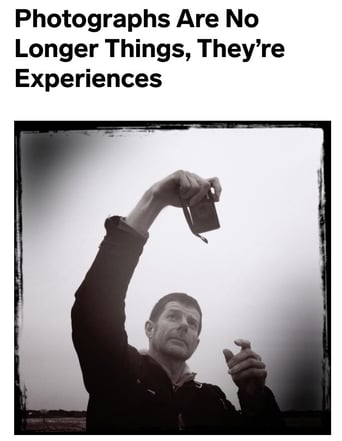What does photography mean to today’s capture on-demand, share anytime and anywhere, mobile and web-savvy generation of parents and their children? And more importantly, why should you care?
Bridging generational change.
Every generation frames their world within the context of their tools and how they use them in everyday life. There is no better way to understand the significance of this than to consider bridge generations, i.e., one that is transitioning from one dominant technology to another. A bridge generation uses and describes things differently than the generation after it. For example, the generation transitioning from using the horse and buggy to the car spoke about the automobile as a horseless carriage. The next generation only talks about the vehicle, no reference to the horse when discussing everyday transportation issues. They’ve fully transitioned into the next era and only frame their daily life experience around car language.
If you are not a Millennial or their child, you are a bridge generation. You describe and experience the world in a very different way than they do – and this matters in the world of professional photography today.
Time and technology change the meaning and experience of photography.
For those who grew up with the 19th century Kodak photography model – one picture, one print; the meaning of photography centered around the singular print and used relevant language when working with images. Photography implied documentation and evidence of a singular moment. Today, many in the professional photography industry have created good businesses around this concept and its language.
Yet, there is a different photography model in everyday use today, and it has little to no connection with the Kodak model. Today’s 21st century paradigm is the smartphone photography archetype. For today's youth and young parents, or anyone that grew up with a smartphone and the ubiquity and fluidity of digital content, they experience photography in a fundamentally different way than prior generations. They give photography a different meaning, interact with it differently, and have a more expansive relationship with the concept of and physical experience of content, imagery and picture taking.
 In a 2008 Wired article, Stephen Mayes gave language to this new model and explained that the rise of digital changed the very nature of photography by moving it from a fixed image to a fluid one. Stephen stated, “Photography is less about document or evidence and more about community and experience ... and that's not a bad thing.” The everyday person in the 21st century sees photography as community and experience – it’s a rich new way to share and connect with one another.
In a 2008 Wired article, Stephen Mayes gave language to this new model and explained that the rise of digital changed the very nature of photography by moving it from a fixed image to a fluid one. Stephen stated, “Photography is less about document or evidence and more about community and experience ... and that's not a bad thing.” The everyday person in the 21st century sees photography as community and experience – it’s a rich new way to share and connect with one another.
Images in this 21st century model are ubiquitous, fluid and anyone and everyone can capture and participate. Today's photos – and I use the plural because no one takes just one – are part of our daily stories, weaving their way into our fabric of shared expression and communication.
The digital, mobile and social divide.
.jpg?width=461&name=robin-worrall-FPt10LXK0cg-unsplash%20(1).jpg) If you are not a Millennial or a child of a Millennial, think about the bridge you are crossing. Think about the world as this new generation experiences it and have been conditioned to experience it. They have their generation’s biases based on the digital tools and services they grew up using and don’t carry the bias of the earlier generation’s tool set. More importantly, these digital tools create innate expectations and habits around buying, shopping, engagement, communication and creating. It’s what they’re accustomed to and it’s what they expect. Consider that:
If you are not a Millennial or a child of a Millennial, think about the bridge you are crossing. Think about the world as this new generation experiences it and have been conditioned to experience it. They have their generation’s biases based on the digital tools and services they grew up using and don’t carry the bias of the earlier generation’s tool set. More importantly, these digital tools create innate expectations and habits around buying, shopping, engagement, communication and creating. It’s what they’re accustomed to and it’s what they expect. Consider that:
- Millennials and their children grew up using the internet via browser technology, which is 25 years old.
- Millennials and their children grew up shopping on Amazon, which is 25 years old.
- Mobile phones have had cameras in them for over 18 years.
- The iPhone is 13 years old, along with a wealth of social and mobile apps
Today’s parents and children view and experience the world via smartphone technology!
This group is not a bridge generation – they are the generation on the other side of the bridge. They don’t know anything but digital technology and the world it allows them to navigate. Millennials and their children are the capture on-demand, share anytime and anywhere, mobile and internet savvy generation. That is their world, and anything else is grandpa’s horse and buggy.
Consumers expectations and understanding of photography today.
The photographic model deployed by the volume industry harks back to the late 19th century – one picture, one print. (Most school photographers only give their parents one portrait.) But today’s youth and parents have only known unlimited photography and sharing of images, as well as a new world of image manipulation and expression. Today’s professional photographer must not only understand this fundamental change but embrace the 21st century model and use it to build and expand their business.
In the 19th century model, prints were the commonly accepted method of viewing an image that a photographer photographed. In the 21st century, the commonly accepted method of viewing an image is on the screen of a smartphone. Anything else is on the other side of the bridge.
One stark example to illustrate this point is the old and new habits of sharing images. Those of us who can remember back to the 80s and 90s saw a time when kids actually shared their own school portraits with friends in the form of wallet prints. How things have changed. The most interesting question to ask is how many kids share their school portraits with friends today? After all, most kids love sharing selfies they take, so why not a professionally captured image of themselves? We all know the answer, but why is that the case? What does it say about the evolution of professional photography? And most importantly, what would happen to your business if BOTH the parents and kids loved the photos you capture and want to share them?

In the 19th century model, prints were the commonly accepted method of sharing and then discussing what was photographed. In the 21st century, the commonly accepted method of sharing an image is through digital communications vehicles and apps – text, Facebook, Instagram, Snapchat, TikTok and more. On the screen of a smartphone, engagement and discussion is so much more than it was in the past.
Embrace the new model to enhance your competitive position.
Embracing the 21st Century Smartphone Photography model and building it into your business helps you connect with today’s generation of customers in their native, digital and mobile language. It demonstrates that you understand them and how they shop, communicate, and where they view and experience photography today. Making the move to meet your customer on their playing field will give your business more market resilience and help you:
- Retain customers
- Increase your relevance and consumer participation
- Extract more cash from current consumers over time because you are not just a photographer, but a content creator with a new digital platform that allows you to monetize your content in new and exciting ways.
- Develop new 21st century services and products that make your business more resistant to competition while creating more cash from the market than slow-to-react competitors
This is not about selling or not selling prints. It is about engaging your consumers on their turf and in the world that they live in today, and then using it to your advantage.
You are monetizing around print today, but it is not today’s cultural norm for engaging, communicating and sharing images, and more importantly, it's not the unique digital content that will delight your consumer. Be mindful of how you are making your business an integral part of the 21st century photography model, and especially how you are leveraging and embracing it to engage, monetize and expand your market. As time and technology have changed the language and experience of photography, it's time for the industry to make the most of the ensuing business opportunities that are emerging because of it.

Tim is a strategic leader with a strong track record of building early-stage technology businesses into leaders in their markets. For the last fifteen years he’s nurtured businesses in the US, Europe, and Asia helping them develop and bring product and services to market in the areas of mobile, digital imaging, SaaS, big data, and IOT technologies. Tim has also been part of senior management teams that have raised $50 million in early-stage venture capital with investors both in and outside the US. At Capturelife, Tim brings his strategic focus to organizational growth and business development.
Looking to modernize the memory experience for your consumers?



Comments